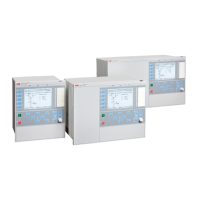Make sure that CS and TRIP output signals appear after the time delays tCS.
3. Switch the operation of the zone 1 distance protection function on and fulfill
all the conditions for single-pole autoreclosing.
4. Simulate a single phase-to-earth fault within the reach of zone 1 and both power-
swing zones.
The fault should cause a single-pole tripping and should be switched off with
the normal operating time of zone 1.
5. Repeat the fault within the dead time of single-pole autoreclosing.
Make sure, that ZMRPSL generates a BLKZMUR signal and no CS and TRIP.
13.5.6.3 Controlling of the underreaching zone
Procedure
1. Set the operation of all normal distance protection zones to On.
2. Simulate a fault without fault resistance in the middle of distance protection
zone 1.
Make sure that the trip appears within the operate time for the distance
protection zone 1 and no BLKZMOR output signal appears.
3. Switch off the fault and prepare a new fault without fault resistance within the
normal distance protection zone 2 operate area, but outside the zone 1 operate
area.
4. Switch on the fault and move it into the zone 1 operate area with a time delay
longer than the time set on the tDZ timer and faster than the time set on timer
tZL.
5. Observe the operate time, which must be equal to the operate time of zone 1,
after the measured impedance enters its operate area.
No delayed operation of zone 1 must be observed.
6. Configure the STPSD functional input to connect to the START functional
output and repeat the previous fault.
Fast trip, caused by the operation of zone 1 must appear with a time delay,
which is equal to the set time delay on the timer tZL plus zone 1 normal
operate time. Also, observe the BLKZMOR functional output signal, which
must appear for a short time.
7. Be sure to establish the original configuration of the IED and the original
settings of all setting parameters.
13.5.6.4 Completing the test
Continue to test another function or end the test by changing the Test mode setting
to Off. Restore connections and settings to their original values, if they were
changed for testing purposes.
13.5.7 Phase preference logic PPLPHIZ
Prepare the IED for verification of settings as outlined in section
"Overview" and
section "Preparing for test" in this chapter.
1MRK 504 088-UEN C Section 13
Verifying settings by secondary injection
133
Installation and commissioning manual

